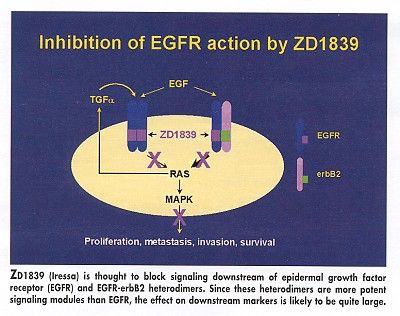Iressa, an EGFR Inhibitor, Shows Preclinical Promise
SAN ANTONIO-ZD1839 (or Iressa), an orally active, selective epidermal growth factor receptor (EGFR) tyrosine kinase inhibitor, slows proliferation of cancer cells that overexpress EGFR and erbB2 (also known as HER-2/neu), according to a study reported by Neil G. Anderson, PhD, of the University of Manchester.
SAN ANTONIOZD1839 (or Iressa), an orally active, selective epidermal growth factor receptor (EGFR) tyrosine kinase inhibitor, slows proliferation of cancer cells that overexpress EGFR and erbB2 (also known as HER-2/neu), according to a study reported by Neil G. Anderson, PhD, of the University of Manchester.
Accumulating research suggests that EGFR plays a role in cell proliferation, invasion, metastasis, and tumor cell survival via multiple signaling pathways. In human tumors, EGFR overexpression is associated with high-grade lesions, invasiveness, and reduced disease-free and overall survival, Dr. Anderson said at the San Antonio Breast Cancer Symposium.
EGFR forms heterodimers with other members of the erb (HER) family, notably erbB2 (HER-2), he said. These heterodimers are believed to induce more intense and prolonged signalingthrough the ras-MAP kinase (ras-MAPK) pathway, for examplethereby inducing greater effects on proliferation in these tumor cells (see Figure).

ZD1839 has been shown to block signal transduction pathways implicated in the proliferation and survival of cancer cells.
"Because EGFR forms heterodimers with erbB2, we hypothesized that inhibition of EGFR might have an effect on cancer cells that overexpress erbB2," Dr. Anderson said. "The aim of our study was to investigate the effects of EGFR blockade with Iressa on the proliferation of EGFR-positive cancer cells that co-express various levels of erbB2."
An initial in vitro experiment evaluated the effects of ZD1839 on a variety of cancer cell lines. The cell lines were classified according to their relative degrees of EGFR and erbB2 expression: high EGFR, relatively low erbB2 expression; high erbB2 and low-to-medium EGFR expression; and relatively low expression of both receptors.
ZD1839 inhibited proliferation in all the cell lines tested. In a high EGFR/low erbB2-expressing breast cancer cell line (MDA-MB231) and a high erbB2/low EGFR-expressing ovarian cancer cell line (SKOV3), ZD 1839 induced around 60% inhibition. In the three high erbB2-overexpressing cell lines tested, inhibition ranged from about 30% to 80%.
Murine Studies
ZD1839 was then tested against MDA-MB231 cells and SKOV3 cells grown in nude mice. The cells were established as tumors and grown for 14 or 21 days. ZD1839 was then administered at a daily dose of 75 mg/kg for 14 days.
The agent severely restricted the growth of the MDA-MB231 cells, which overexpress EGFRwith an approximately 70% reduction of tumor growth after 14 days, Dr. Anderson said. "In the SKOV3 erbB2-overexpressing cell line, the effect was not as great, but we did get a significant reduction in tumor growth, approximately 30%, after 14 days’ treatment," he said.
The researchers also evaluated ZD1839’s effects on the activation status of ERK MAP kinase in the tumors. Treatment led to an "almost complete wipeout" of two isomers of ERK MAP in the MDA-MB231 cells and significantly inhibited the activation of these enzymes in the erbB2-overexpressing SKOV3 cells.
"Overall, our results suggest that Iressa is a strong inhibitor of EGF receptor activity, thus blocking signaling downstream of these complexes," Dr. Anderson said. "But it also appears to be able to block signaling downstream of EGFR-erbB2 heterodimers. And, as these are more potent signaling modules, the effect on downstream markers, such as proliferation, is likely to be quite large."
The study results, he added, suggest that ZD1839 has therapeutic potential for EGFR-positive cancers, whether or not they overexpress erbB2.
Late Hepatic Recurrence From Granulosa Cell Tumor: A Case Report
Granulosa cell tumors exhibit late recurrence and rare hepatic metastasis, emphasizing the need for lifelong surveillance in affected patients.